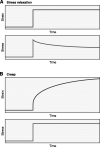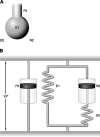Lung parenchymal mechanics in health and disease
- PMID: 19584312
- PMCID: PMC7203567
- DOI: 10.1152/physrev.00019.2007
Lung parenchymal mechanics in health and disease
Abstract
The mechanical properties of lung tissue are important determinants of lung physiological functions. The connective tissue is composed mainly of cells and extracellular matrix, where collagen and elastic fibers are the main determinants of lung tissue mechanical properties. These fibers have essentially different elastic properties, form a continuous network along the lungs, and are responsible for passive expiration. In the last decade, many studies analyzed the relationship between tissue composition, microstructure, and macrophysiology, showing that the lung physiological behavior reflects both the mechanical properties of tissue individual components and its complex structural organization. Different lung pathologies such as acute respiratory distress syndrome, fibrosis, inflammation, and emphysema can affect the extracellular matrix. This review focuses on the mechanical properties of lung tissue and how the stress-bearing elements of lung parenchyma can influence its behavior.
Figures




Similar articles
-
Extracellular matrix mechanics in lung parenchymal diseases.Respir Physiol Neurobiol. 2008 Nov 30;163(1-3):33-43. doi: 10.1016/j.resp.2008.03.015. Epub 2008 Apr 8. Respir Physiol Neurobiol. 2008. PMID: 18485836 Free PMC article. Review.
-
Biomechanics of the lung parenchyma: critical roles of collagen and mechanical forces.J Appl Physiol (1985). 2005 May;98(5):1892-9. doi: 10.1152/japplphysiol.01087.2004. J Appl Physiol (1985). 2005. PMID: 15829722 Review.
-
Age-dependent changes of airway and lung parenchyma in C57BL/6J mice.J Appl Physiol (1985). 2007 Jan;102(1):200-6. doi: 10.1152/japplphysiol.00400.2006. Epub 2006 Aug 31. J Appl Physiol (1985). 2007. PMID: 16946023
-
Maturational changes in extracellular matrix and lung tissue mechanics.J Appl Physiol (1985). 2001 Nov;91(5):2314-21. doi: 10.1152/jappl.2001.91.5.2314. J Appl Physiol (1985). 2001. PMID: 11641376
-
Lung tissue mechanics and extracellular matrix remodeling in acute lung injury.Am J Respir Crit Care Med. 2001 Sep 15;164(6):1067-71. doi: 10.1164/ajrccm.164.6.2007062. Am J Respir Crit Care Med. 2001. PMID: 11587998
Cited by
-
Effect of Substrate Stiffness on Physicochemical Properties of Normal and Fibrotic Lung Fibroblasts.Materials (Basel). 2020 Oct 10;13(20):4495. doi: 10.3390/ma13204495. Materials (Basel). 2020. PMID: 33050502 Free PMC article.
-
A model of lung parenchyma stress relaxation using fractional viscoelasticity.Med Eng Phys. 2015 Aug;37(8):752-8. doi: 10.1016/j.medengphy.2015.05.003. Epub 2015 Jun 3. Med Eng Phys. 2015. PMID: 26050200 Free PMC article.
-
Lymph node biophysical remodeling is associated with melanoma lymphatic drainage.FASEB J. 2015 Nov;29(11):4512-22. doi: 10.1096/fj.15-274761. Epub 2015 Jul 15. FASEB J. 2015. PMID: 26178165 Free PMC article.
-
Intracycle power and ventilation mode as potential contributors to ventilator-induced lung injury.Intensive Care Med Exp. 2021 Nov 1;9(1):55. doi: 10.1186/s40635-021-00420-9. Intensive Care Med Exp. 2021. PMID: 34719749 Free PMC article.
-
Fibroblasts-Warriors at the Intersection of Wound Healing and Disrepair.Biomolecules. 2023 Jun 6;13(6):945. doi: 10.3390/biom13060945. Biomolecules. 2023. PMID: 37371525 Free PMC article. Review.
References
-
- Agostoni E, Hyatt RE. Static behavior of the respiratory system. In: Handbook of Physiology. The Respiratory System. Mechanics of Breathing. Bethesda, MD: Am. Physiol. Soc. 1986, sect. 3, vol. III, pt. 1, chapt. 9, p. 113–130.
-
- Al Jamal R, Roughley PJ, Ludwig MS. Effect of glycosaminoglycan degradation on lung tissue viscoelasticity. Am J Physiol Lung Cell Mol Physiol : L306–L315, 2001. - PubMed
-
- Antonaglia V, Peratoner A, De Simoni L, Gullo A, Milic-Emili J, Zin WA. Bedside assessment of respiratory viscoelastic properties in ventilated patients. Eur Respir J : 302–308, 2000. - PubMed
-
- Aoshiba K, Yokohori N, Nagai A. Alveolar wall apoptosis causes lung destruction and emphysematous changes. Am J Respir Cell Mol Biol : 555–562, 2003. - PubMed
Publication types
MeSH terms
Substances
LinkOut - more resources
Full Text Sources
Medical

